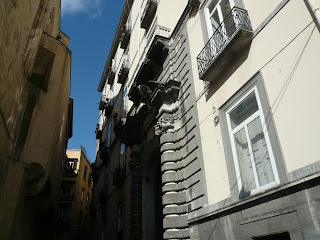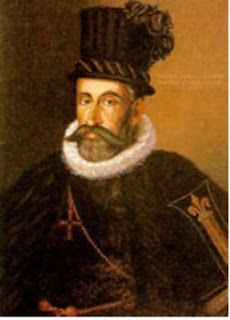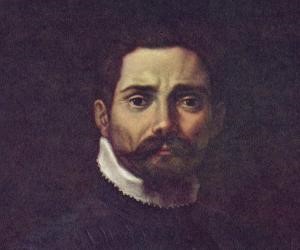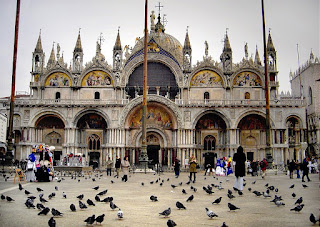Medici musician who invented the madrigal comedy
Although there is no accurate record of his age, it is thought he was born in 1536 or 1537, which would have put him in his mid-50s at the time of his death.
Striggio spent much of his career in the employment of the Medici family in Florence, for whom he also served as a diplomat, undertaking visits to Munich, Vienna and London among other places on their behalf.
He produced his best work while working for the Medici, composing madrigals, dramatic music, and intermedi - musical interludes - to be played between acts in theatrical performances.
Striggio’s best known composition is his Il cicalamento delle donne al bucato e la caccia (The gossip of the women at the laundry), an innovative piece that combined music and words to tell a story, without acting. This was an example of what became known as the madrigal comedy, comprising a series of 15 humorous madrigals that together tell a story in words and music.
Perhaps his greatest achievements, though, were his choral works, including his motet Ecce beatam lucem, a feat of polyphony that included 40 independent voices, and his still more impressive Mass, Missa sopra Ecco sì beato giorno, which also featured 40 different voice parts and a final movement for 60 voices, which is thought to be the only piece of 60-part counterpoint in the history of Western Music.
 |
| Cosimo I de' Medici sent Striggio on a diplomatic mission to Vienna |
In the 1560s, he visited Venice and produced two books of madrigals influenced by the musical styles he encountered there.
Music was central to the Medici’s use of Striggio in a diplomatic role. Cosimo I craved the title of Archduke or Grand Duke, which within the hierarchy of the Holy Roman Empire was a rank below Emperor but a notch above Duke and equivalent to a King.
He ordered Striggio to travel to Vienna in the winter of 1566-67, sending his principal musician on a perilous journey through the Brenner Pass in order to meet Emperor Maximilian II and present Cosimo’s case for the Medici to be granted a royal title.
Striggio’s grand opus, Missa sopra Ecco sì beato giorno, was to be part of the presentation, underlining Cosimo’s commitment to the Catholic faith. Striggio was also charged with convincing Maximilian II that the Medici could support him both financially and militarily.
Unfortunately, Striggio reached Vienna only to find he needed to journey a further 140km (87 miles) north to Brno, where Maximilian had removed himself for the winter months. He presented the Emperor with a copy of the Mass, although he had too few musicians or singers with him in Brno for the piece to be performed.
.jpg) |
| The English composer Thomas Tallis is said to have been inspired by Striggio |
Striggio went on to visit England, having much respect for the work of musicians in the royal court there. He is said to have met Queen Elizabeth I and the composer Thomas Tallis, who had served in the courts of four monarchs - Henry VIII, Edward VI and Mary I, as well as Elizabeth I - and is considered one of England’s greatest composers, particularly of choral music. His own 40-voice motet, Spem in alium, is thought to have been inspired by his meeting with Striggio.
Striggio returned to Florence, where he became friends with Vincenzo Galilei, the lutenist and composer whose son was the astronomer and scientist, Galileo Galilei.
During the 1580s, Striggio began an association with the Este court in Ferrara, which at the time was at the forefront of musical composition in Italy. In 1586, he moved back to his home city, Mantua, although he would continue to compose music for the Medici at least until 1589.
Although the idea of Striggio’s madrigal comedy being the forerunner of opera is no longer widely held, the composer has a connection with the roots of opera in that his son, also called Alessandro, wrote the libretto of Claudio Monteverdi's L'Orfeo, one of the earliest works to fit the conventional definition of an opera.
As a footnote, the score of Striggio’s Missa sopra Ecco sì beato giorno was declared lost in 1726 but was rediscovered in 2007 by a musicologist from the University of California, Berkeley in the Bibliothèque nationale de France in Paris, where it had resided for most of the intervening years, unnoticed because it had reportedly been recorded in an inventory of manuscripts as being a four-part Mass by a composer called Strusco.
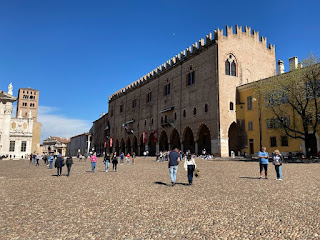 |
| The Ducal Palace is one of many highlights of the atmospheric city of Striggio's home city |
Mantua is an atmospheric old city in Lombardy, to the southeast of Milan, famous for its Renaissance Palazzo Ducale, the seat of the Gonzaga family between 1328 and 1707. In the Renaissance heart of Mantua is Piazza Mantegna, where the 15th century Basilica of Sant’Andrea houses the tomb of the artist, Andrea Mantegna. The church was originally built to accommodate the large number of pilgrims who came to Mantua to see a precious relic, an ampoule containing what were believed to be drops of Christ’s blood mixed with earth. This was claimed to have been collected at the site of his crucifixion by a Roman soldier. In nearby Piazze delle Erbe is the Chiesa di San Lorenzo, another masterpiece of Renaissance architecture. Its elegant facade and interior are adorned with beautiful artwork and sculptures. In the same square, the Torre dell’Orologio Astronomico - the Astronomical Clock Tower - displays lunar cycles as well as the time. Installed in 1473, the clock has failed twice but was restored in 1989.
Hotels in Mantua by Booking.com
 |
| Palazzo Vecchio was at one time Cosimo I's home |
Florence’s imposing Palazzo Vecchio, formerly Palazzo della Signoria, a cubical building of four storeys made of solid rusticated stonework, crowned with projecting crenellated battlements and a clock tower rising to 94m (308ft), became home of Duke Cosimo I de' Medici moved his official seat from the Medici palazzo in via Larga in May 1540. When Cosimo later removed to Palazzo Pitti, he officially renamed his former palace the Palazzo Vecchio, the "Old Palace", although the adjacent town square, the Piazza della Signoria, still bears the original name. Cosimo commissioned the painter and architect Giorgio Vasari to build an above-ground walkway, the Vasari corridor, from the Palazzo Vecchio, through the Uffizi, over the Ponte Vecchio to the Palazzo Pitti. Cosimo I also moved the seat of government to the Uffizi, which translated literally, simply means ‘offices’. Today, of course, the Uffizi, is known the world over for its collection of art treasures.
Book your stay in Florence with Booking.com
More reading:
Gonzaga court violinist Salomone Rossi, the leading Jewish musician of the Renaissance
Cosimo II de' Medici, patron of Galileo
Claudio Monteverdi, the Baroque composer who wrote the first real opera
Also on this day
1792: The birth of composer Gioachino Rossini
(Picture credit: Palazzo Vecchio by Geobia via Wikimedia Commons)
(Paintings: Portrait of Cosimo I de' Medici, Bronzino, Art Gallery of New South Wales)







